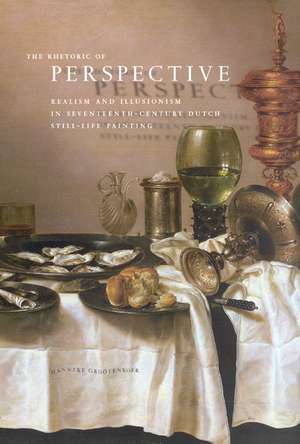The Rhetoric of Perspective: Realism and Illusionism in Seventeenth-Century Dutch Still-Life Painting
Autor Hanneke Grootenboeren Limba Engleză Hardback – 11 iul 2005
Perspective determines how we, as viewers, perceive painting. We can convince ourselves that a painting of a bowl of fruit or a man in a room appears to be real by the way these objects are rendered. Likewise, the trick of perspective can prevent us from being absorbed in a scene. Connecting contemporary critical theory with close readings of seventeenth-century Dutch visual culture, The Rhetoric of Perspective puts forth the claim that painting is a form of thinking and that perspective functions as the language of the image.
Aided by a stunning full-color gallery, Hanneke Grootenboer proposes a new theory of perspective based on the phenomenological aspects of non-narrative still-life, trompe l'oeil, and anamorphic imagery. Drawing on playful and mesmerizing baroque images, Grootenboer characterizes what she calls their "sophisticated deceit," asserting that painting is more about visual representation than about its supposed objects.
Offering an original theory of perspective's impact on pictorial representation, the act of looking, and the understanding of truth in painting, Grootenboer shows how these paintings both question the status of representation and explore the limits and credibility of perception.
Aided by a stunning full-color gallery, Hanneke Grootenboer proposes a new theory of perspective based on the phenomenological aspects of non-narrative still-life, trompe l'oeil, and anamorphic imagery. Drawing on playful and mesmerizing baroque images, Grootenboer characterizes what she calls their "sophisticated deceit," asserting that painting is more about visual representation than about its supposed objects.
Offering an original theory of perspective's impact on pictorial representation, the act of looking, and the understanding of truth in painting, Grootenboer shows how these paintings both question the status of representation and explore the limits and credibility of perception.
“An elegant and honourable synthesis.”—Keith Miller, Times Literary Supplement
Preț: 587.28 lei
Preț vechi: 762.70 lei
-23% Nou
Puncte Express: 881
Preț estimativ în valută:
112.41€ • 122.15$ • 94.49£
112.41€ • 122.15$ • 94.49£
Carte tipărită la comandă
Livrare economică 21 aprilie-05 mai
Preluare comenzi: 021 569.72.76
Specificații
ISBN-13: 9780226309682
ISBN-10: 0226309681
Pagini: 246
Ilustrații: 24 color plates, 1 halftone, 2 line drawings
Dimensiuni: 152 x 229 x 18 mm
Greutate: 0.64 kg
Ediția:1
Editura: University of Chicago Press
Colecția University of Chicago Press
ISBN-10: 0226309681
Pagini: 246
Ilustrații: 24 color plates, 1 halftone, 2 line drawings
Dimensiuni: 152 x 229 x 18 mm
Greutate: 0.64 kg
Ediția:1
Editura: University of Chicago Press
Colecția University of Chicago Press
Notă biografică
Hanneke Grootenboer is lecturer in the Department of Art History and Archaeology at Columbia University.
Cuprins
List of Illustrations
Acknowledgments
Introduction: The Thought of Painting
1. The Invisibility of Depth
Merleau-Ponty, Lacan, and the Lure of Painting
2. Truth in Breakfast Painting
Horror Vacui versus the Void and Pascal's Geometrical Rhetoric
3. The Rhetoric of Perspective
Panofsky, Damisch, and Anamorphosis
4. Perspective as Allegorical Form
Vanitas Painting and Benjamin's Allegory of Truth
Conclusion: The Look of Painting
Notes
Bibliography
Index
Acknowledgments
Introduction: The Thought of Painting
1. The Invisibility of Depth
Merleau-Ponty, Lacan, and the Lure of Painting
2. Truth in Breakfast Painting
Horror Vacui versus the Void and Pascal's Geometrical Rhetoric
3. The Rhetoric of Perspective
Panofsky, Damisch, and Anamorphosis
4. Perspective as Allegorical Form
Vanitas Painting and Benjamin's Allegory of Truth
Conclusion: The Look of Painting
Notes
Bibliography
Index
Recenzii
"This is a lucid, sustained meditation on one of the most difficult ideas that the twentieth century produced about painting: that an image is somehow a form of thinking or a model of thought. Grootenboer follows her theme through its tangled genealogy in Heidegger, Merleau-Ponty, Lacan, and Damisch, weaving in examples of Dutch still-life painting. This book should be required reading for those interested in the conceptualization of painting."
"A remarkable book. The Rhetoric of Perspective is one of the soundest pieces of post-structuralist writing that the discipline has produced. The prose is lucid and crisp and, at times, poetic. Grootenboer's reading of these paintings generates a striking argument about perspective with implications far beyond the seventeenth-century Dutch field, indeed beyond disciplines of art history."
“One always wonders how a classical subject, so often recounted, analyzed, recast that it becomes boring, can be vitalized and made all exciting again. Grootenboer manages this for Dutch still-life painting with amazing brilliance. This is a profoundly innovative book, bringing both still life painting and the scholarship about it an entirely new second life. A must-read book for all interested in painting.”
“The book represents an elegant and honourable synthesis of some difficult writers. It is clear where they are often aggressively theoretical, and reasonable where they are declamatory. It has, in short, the same sort of patient intellectual integrity that Grootenboer attributes to the still-life painters themselves.”
“A fresh turn with the thoughts and methods of Heidegger, Pascal, Barthes, Lacan, and Merleau-Ponty . . . . Tightly focused and yet broadly significant, The Rhetoric of Perspective represents a bold act of ‘historiographic experimentation’. . . . Admirably, the book enacts some of the very traits of its subject -- moderation, modesty, and restraint—about specific images that in turn generate a persuasive clarity about greater ideas. Grootenboer advances, in a sterling exposition, the worthy project of understanding the genre of still life. . . . A book respectable in every detail.”
